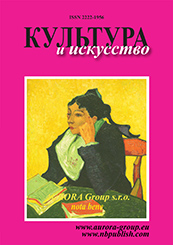Изобразительные искусства
Правильная ссылка на статью:
Желнова Е.Г.
«Меркурий и Аргус» П. И. Соколова: эстетика картины, поиск художественного образа, восприятие современниками
// Культура и искусство.
2024. № 4.
С. 1-13.
DOI: 10.7256/2454-0625.2024.4.70302 EDN: SZHBPH URL: https://nbpublish.com/library_read_article.php?id=70302
Читать статью
Результаты процедуры рецензирования статьи:
Результаты процедуры повторного рецензирования статьи:
|
EDN: SZHBPH

|
Аннотация:
Целью данной статьи является анализ картины П. И. Соколова (1753–1791) «Меркурий и Аргус» (1776 г.) в контексте художественных предпочтений эпохи. Задачи исследования: проанализировать подготовительные рисунки и картину; изучить архивные источники, рапорты художника; выявить процесс работы над картиной; обозначить отражение в картине эстетических идеалов эпохи и восприятие современниками. Объектом нашего внимания станет художественный процесс создания во второй половине XVIII в. исторической картины на примере произведения П. И. Соколова «Меркурий и Аргус». Предметом исследования является роль набросков, зарисовок с натуры, эскиза композиции в работе П. И. Соколова над картиной «Меркурий и Аргус». Автор рассматривает приемы изобразительной техники, характер образно-пластического языка, подготовительный графический материал, выявляя процесс работы над картиной, основывающийся на академической системе образования. Приводя цитаты из писем, рапортов и сочинений второй половины XVIII в., автор анализирует, что было характерно для искусства исследуемого периода, какие задачи ставил для себя художник, какие условия были необходимы для выразительности визуального образа и идеи картины, а также достижения ее положительной оценки современниками. В ходе изучения картины, подготовительных рисунков, а также рапортов П. И. Соколова были применены следующие методы: формальный, формально-стилистический, искусствоведческий анализ. Автор приходит к выводу, что работа над картиной на историческую тему во второй половине XVIII в. включала в себя большой планомерный творческий процесс, диктуемый академической системой образования в Императорской академии художеств. Анализ картины, подготовительных рисунков и эскиза композиции показал, что выполнение рисунков с натуры, зарисовок отдельных частей и фрагментов будущей композиции, стали основой последующего поиска лучшего образа. Историческая живопись второй половины XVIII в. отражала эстетические воззрения и идеалы эпохи, являясь художественным воплощением идей теоретических трактатов и сочинений, направленных на совершенствование изобразительного образа. Новизна исследования заключается в рассмотрении картины не только как части художественного наследия мастера, но и как отражение академической системы образования в Императорской академии художеств второй половины XVIII в. и эстетики просветительского классицизма.
Ключевые слова:
историческая живопись, искусство XVIII века, академик исторической живописи, Петр Иванович Соколов, Императорская академия художеств, классицизм, подготовительный рисунок, рисунок с натуры, живопись, графика
Abstract:
Purpose of this article is analysis of painting by P. I. Sokolov (1753-1791) «Mercury and Argus» (1776) in context preferences of era. Objectives of study: analyze preparatory drawings and picture; study archival sources, artist reports; reveal process of painting; represent aesthetic ideals of epoch and perception of personality. Our focus will be on artistic process of creation historical picture in second half of XVIII century on example of work by P. I. Sokolov «Mercury and Argus». Research subject is role of sketches from nature, sketch composition in work of P. I. Sokolov on picture «Mercury and Argus». Author considers of visual technique, graphic-plastic composition, preparatory graphic, identifying process of working on picture based on academic education system. Citing quotes from letters, reports and writings of second half of XVIII century author analyses what was typical for art of period under study, what tasks artist set for himself, what conditions were necessary for expressiveness of visual image and idea of picture as well as her positive evaluation by her contemporaries. During study were applied: formal, formal-stylistic, art criticism analysis. Author comes to conclusion that work on historical painting in second half of XVIII century included a large systematic creative process dictated by academic education system at Imperial Academy of Arts. Analysis showed that execution of sketches and drawings from nature became basis for subsequent search for better image. Historical painting of second half of XVIII century reflected aesthetic views and ideals of era, being an artistic embodiment of ideas of theoretical treatises aimed at improving visual image. Novelty of research lies in considering painting not only as part of artistic heritage, but also as a reflection of academic education system at Imperial Academy of Arts in second half of XVIII century and aesthetics of educational classicism.
Keywords:
painting, life drawing, classicism, preparatory drawing, The Imperial Academy of arts, academician of historical painting, Petr Ivanovich Sokolov, art of XVIII century, historical painting, graphics
 Статья опубликована с лицензией Creative Commons Attribution-NonCommercial 4.0 International License (CC BY-NC 4.0) – Лицензия «С указанием авторства – Некоммерческая».
Статья опубликована с лицензией Creative Commons Attribution-NonCommercial 4.0 International License (CC BY-NC 4.0) – Лицензия «С указанием авторства – Некоммерческая». Рус
Рус














 © 1998 – 2024 Nota Bene. Publishing Technologies. NB-Media Ltd.
© 1998 – 2024 Nota Bene. Publishing Technologies. NB-Media Ltd.




